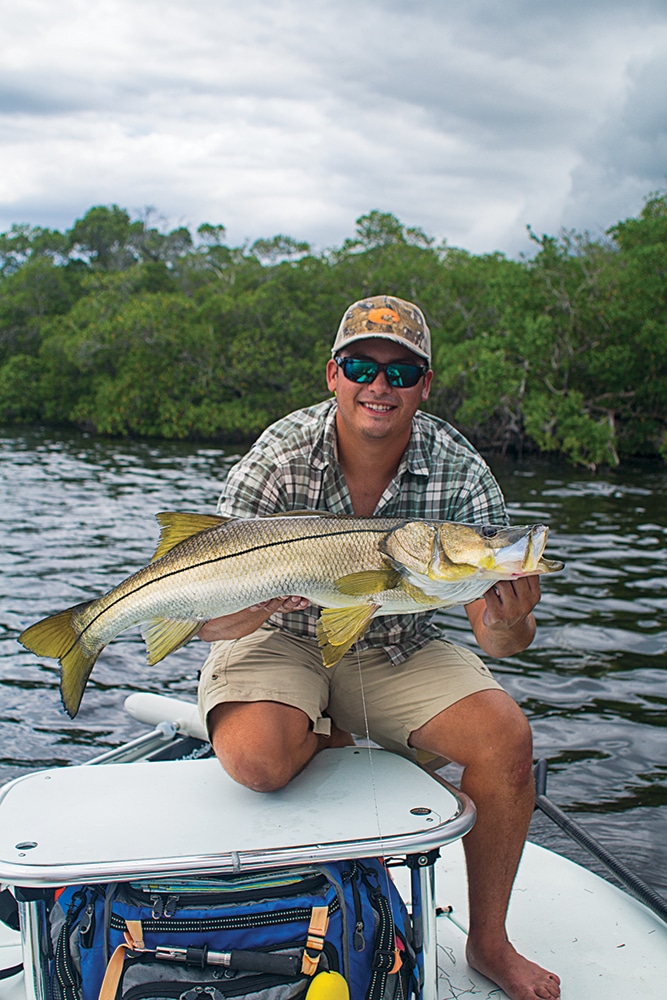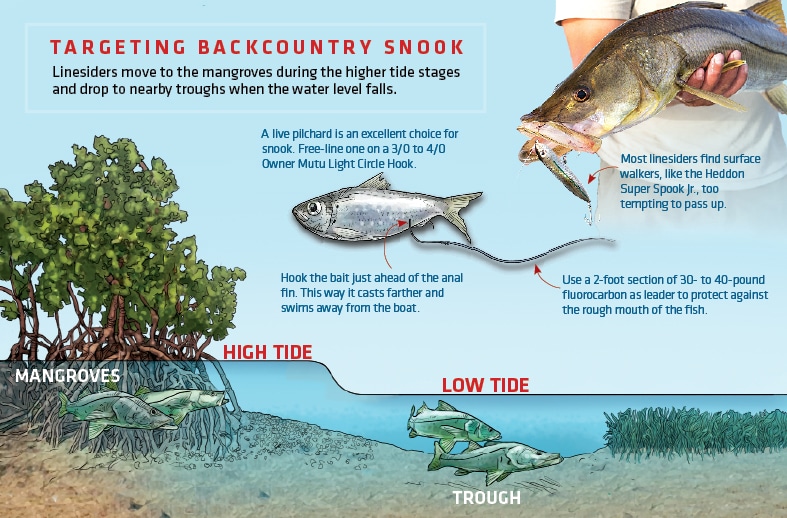
A stiff, chilly breeze had started blowing and loud thunder had just made me recoil when fabian guerrero set the hook on a big one. “Finally, a snook with some shoulders,” i said, as my young sidekick pulled hard on the grip of his spinning rod, keeping the bent tip to the right and parallel to the water to coax the powerful fish away from the safety of the mangroves.
In true lunker fashion, the husky linesider turned tail toward cover as soon as it realized it was hooked, stripping line from the reel despite the tight drag. But Fabian fought the fish masterfully, changing angles and dipping his rod tip in the water as necessary to keep his line intact and the snook coming to the boat. After my longest five minutes in recent memory, I slipped the landing net around the 17-pounder, an impressive fish, quite dark, surely from a long stint in tannic waters. Fist pumps and snapshots were in order before we revived the big snook and sent it on its way with our appreciation.

Lifelong Pursuit
I was in high school when I read my first fishing article: a feature in this very magazine that described tactics for how to catch snook at a time when anglers and fish were considerably less sophisticated than their modern counterparts. Upon learning such a prized game fish could be waiting in ambush in waters near me, I armed myself with a handful of 52 Series MirrOlures and bucktail jigs and began my pursuit of linesiders, an endeavor that remains as rewarding today as when it began 35 years ago.
Although I no longer reside in prime snook territory, the thought of battling those junkyard dogs always proves incentive enough to drive a few hours. Summer heat had finally surrendered to milder weather when I got the urge again, so I asked Fabian Guerrero, my nephew, to join me for a couple of days of fall snooking in the tangled surroundings of southwest Florida’s mangrove country.
I trailered my skiff and met Fabian in Matlacha, a Gulf Coast community surrounded by bays and creeks teeming with snook. We planned our trip to coincide with an early high tide in Pine Island Sound and Matlacha Pass, one that would push 2 feet of water against the shorelines, enough to let snook take up battle stations under the mangroves and slowly crawl out as the tide fell.

Live Option
Intent on targeting the female elders of the tribe — usually the largest snook — we initially opted to live-bait the mouths of several creeks. The bait available, however, left a lot to be desired. Pilchards, known locally as whitebait, were plentiful but small. We’d hoped for 3- to 4-inchers, but despite an extensive search, our netting efforts yielded mostly 2-inch baits. Yes, elephants eat peanuts, but so do a lot of smaller critters. Larger baits not only tempt bigger snook, they also deter thieving undesirables, like ladyfish, catfish and small jacks. The fish we caught at the first few spots confirmed our fears: Our baits were too darn small. Most were intercepted by voracious mangrove snapper, along with a few redfish and a number of sneeks (tiny snook) under 18 inches.
Our persistence was eventually rewarded with the 17-pounder, but when we discussed our options for the next day, we agreed it made sense to forgo live-baiting and run-and-gun with artificials instead. Welcoming the opportunity to move around and blind-cast, we simply examined satellite maps to pinpoint spots we ought to fish, then checked tide tables and the hourly weather forecast to put together our itinerary.

Double Indemnity
Aside from the obvious use of a trolling motor, run-and-gunning backcountry snook calls for teamwork and, in my opinion, two different types of lures: a topwater walker and a soft-plastic jerkbait. The surface plug draws the fish’s attention and usually warrants the most strikes — many decidedly explosive — yet it produces fewer hookups, as big snook often blow up on the lure and launch it out of the water or push it away unintentionally. A second angler using a jerkbait cashes in, however, getting solid subsurface hook-sets on fish amped up by the commotion the topwater caused.
For friendship’s sake, incidentally, you might want to swap lures with your buddy after every fish or two. Unless, of course, the one using the topwater lure happens to be an adrenaline junkie willing to accept a lower hookup ratio to experience astonishing surface fireworks.

Run-and-Gun
The next morning, Fabian rigged with a Super Spook Jr. and I tied on a PowerBait Jerk Shad on a 4/0 Owner Twistlock 1⁄8-ounce weighted hook. It didn’t take us long to put both to good use. We’d made only a dozen casts at our first stop when a heavy fish pounced on my jerkbait. Though the take was subtle, the ensuing fight was anything but. Upon feeling the stab of my hook, the snook tried mightily to get around the shoreline point before us. Luckily, the fish succumbed to my constant pressure, and after a couple more failed escape attempts, I clamped my fingers around the jaw of the 13-pound beauty.
My next hookup did not end as well, though surely the fish feels differently. A snook of larger proportions ate my soft plastic not 20 yards from where I hooked my first fish and quickly broke me off in the trees. But the loss was soon forgotten as Fabian and I went on a hot streak that began with several nerve-racking near misses and ended with three nice snook up to 11 pounds posing for pictures. Walking the dog with the little Spook sure was getting the fish fired up, just like it was supposed to. Some hit it shortly after it landed, tight against the mangroves; others followed it out and blasted the fake finger mullet before it could get away. Meanwhile, the jerkbait proved to be easy pickings.
Team Effort
It was close to noon when the falling tide finally began slowing down. All morning I worked my Jerk Shad near mangrove roots with a streaky stop-and-go action, allowing enough time between jerks to let it sink a few inches, giving the appearance of a floundering baitfish. Simultaneously, my nephew kept his artificial zigzagging on top. We hit six or seven different mangrove shorelines, plucking a snook or two from nearly all, but once the water had dropped a foot or so, it was time to concentrate on troughs and sand holes instead of the mangroves.
A laydown protruding off the end of a small island caught my eye, so I dropped a cast alongside. My lure hadn’t traveled 5 feet when it stopped with a heavy jolt. I instinctively reared back the rod and found myself battling yet another snook. With the mangrove roots almost completely high and dry, the fish had been sitting in a sand trough that ran parallel to the shoreline, and it was forced to stay away from obstacles that bring so many snook fights to an abrupt and early conclusion. With such an advantage, I quickly managed to bring the 10-pounder to the boat. Fabian then did the honors, and with the tide close to dead low, we ended our Gulf Coast snook trip on a high note.









